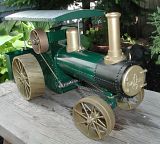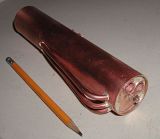Getting close to finishing a model steam tractor of Rudy Kouhoupts design. Have article from Feb. 1971 Popular Mechanics, the plans and the pages of instruction.
One problem is that Rudy makes no mention on operating instructions.
This is a water tube horizontal copper boiler of about 14 cubic inches. There is no sight glass or try cocks. There is a inlet with valve that enters boiler at the center line. Rudy says This valve will double for checking the water level in the boiler and as a connection where you can pump water into the boiler --- No mention of how much water to put in the boiler.
Village Press is coming out with a book on this model. Having finished making the tractor, dont think Im interested in buying the book when it comes out.
The boiler was hydro tested at 120 psi. Relief valve is fully open at 30 psi and working pressure is recommended at 15 psi.
The fire is from dual wick burners fed from a fuel tank of about 5 to 5 and half cubic inches. Guessing fuel to use is alcohol. There is no means to stop flow of fuel or easy way to put fire out.
Looking for advice on how to operate.
Fill with water to water inlet level, half full?
Fill with fuel (alcohol?) and run till fire burns out?
Let cool off before refilling?

One problem is that Rudy makes no mention on operating instructions.
This is a water tube horizontal copper boiler of about 14 cubic inches. There is no sight glass or try cocks. There is a inlet with valve that enters boiler at the center line. Rudy says This valve will double for checking the water level in the boiler and as a connection where you can pump water into the boiler --- No mention of how much water to put in the boiler.
Village Press is coming out with a book on this model. Having finished making the tractor, dont think Im interested in buying the book when it comes out.
The boiler was hydro tested at 120 psi. Relief valve is fully open at 30 psi and working pressure is recommended at 15 psi.
The fire is from dual wick burners fed from a fuel tank of about 5 to 5 and half cubic inches. Guessing fuel to use is alcohol. There is no means to stop flow of fuel or easy way to put fire out.
Looking for advice on how to operate.
Fill with water to water inlet level, half full?
Fill with fuel (alcohol?) and run till fire burns out?
Let cool off before refilling?






